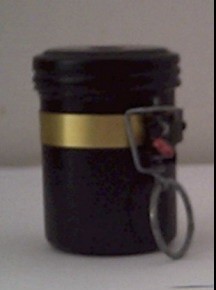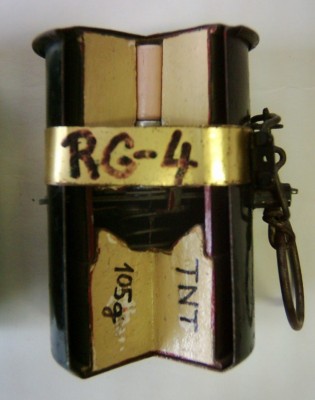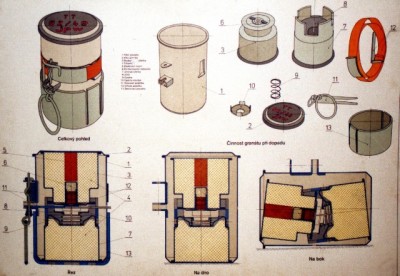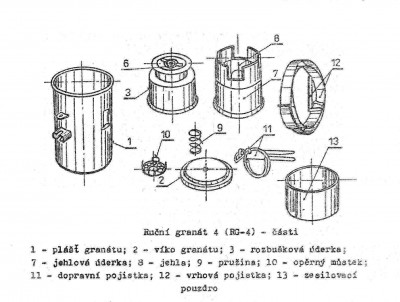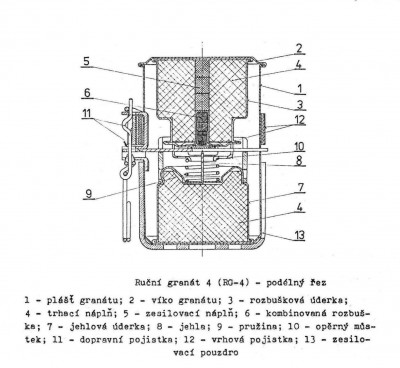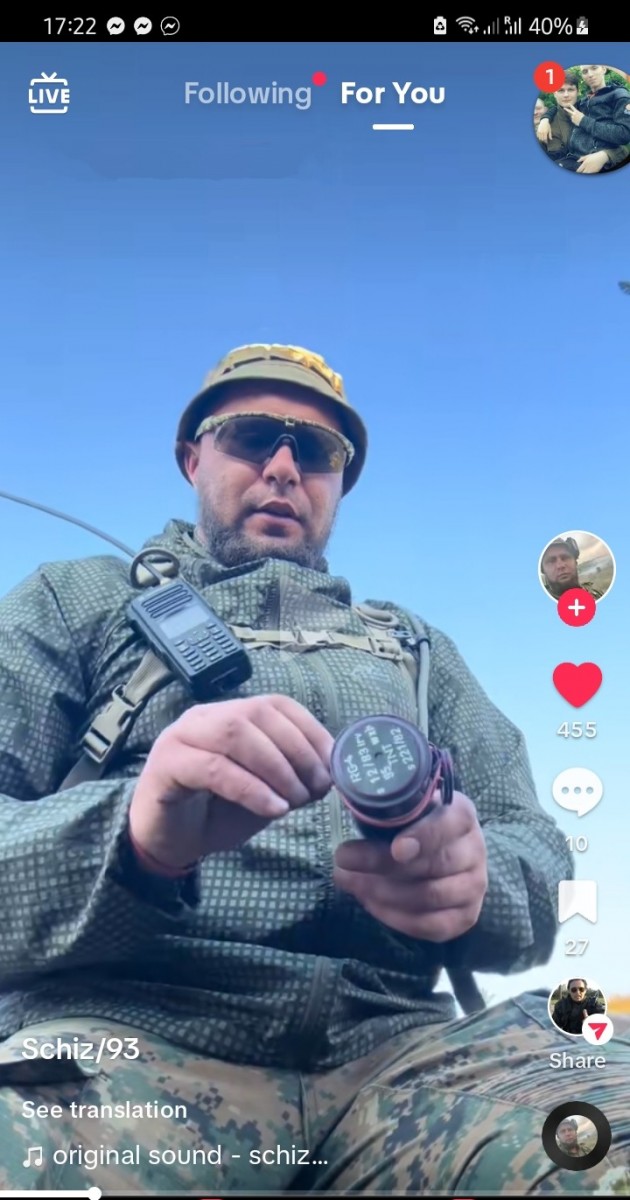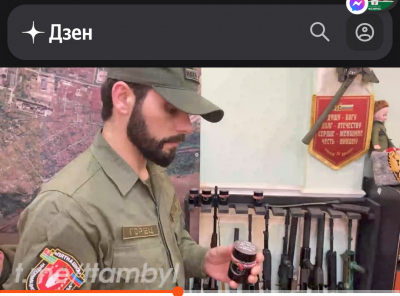| Název: Name: | RG 4 | RG 4 |
| Originální název: Original Name: | RG 4 | |
| Kategorie: Category: | útočný ruční granát | assault hand grenade |
| Výrobce: Producer: | DD.MM.RRRR-DD.MM.RRRR ?, ? | |
| Technické údaje: Technical Data: | ||
| Celková hmotnost: Overall Weight: | 0,322 kg | 0.71 lb |
| Hmotnost bojové nálože: Charge Weight: | 0,11 kg | 0.243 lb |
| Druh bojové nálože: Type of Charge: | trhavá, Trinitrotoluen (TNT) | Fragmentation, Trinitrotoluen (TNT) |
| Zapalovač: Fuse: | nárazový | impact |
| Celková délka: Overall Length: | 84 mm | 3 ¼ in |
| Celková šířka (průměr): Overall Width (diameter): | 53 mm | 2 ⅛ in |
| Celková výška: Overall Height: | 84 mm | 3 ¼ in |
| Účinnost: Efficiency: | Smrtící účinek: 5 – 10 m Zranění: do 200 m | Lethal effect: 16 - 33 ft Wound: up to 656 ft |
| Uživatelské státy: User States: | ||
| Poznámka: Note: | 1)válečná kořist | 1)spoils of war |
| Zdroje: Sources: | Základní vojenská příručka, Naše vojsko, Praha, 1981 | |
CZK - RG 4
Hand Grenade 4 (RG4)
It is an offensive and impact grenade.
The hand grenade 4 is relatively sensitive, which explodes safely even when it hits water, snow, straw, hay and bushes.
The grenade explodes after hitting an obstacle. During the explosion, the grenade is torn into a large number of small fragments with a lethal effect within a radius of 5 to 10 meters and with a wounding effect up to a radius of 200 meters.
The hand grenade 4 can be thrown from any position (standing, lying down, kneeling).
Height ............................................ 84 mm
Diameter ......................................... 53 mm
Weight ....................................... 322 g
Weight of explosive charge ................. 110 g
Deadly effect ........................... 5 - 10 m
Injuries ....................................... 200 m
Number of grenades in the box ................... 25 pcs
It is an offensive and impact grenade.
The hand grenade 4 is relatively sensitive, which explodes safely even when it hits water, snow, straw, hay and bushes.
The grenade explodes after hitting an obstacle. During the explosion, the grenade is torn into a large number of small fragments with a lethal effect within a radius of 5 to 10 meters and with a wounding effect up to a radius of 200 meters.
The hand grenade 4 can be thrown from any position (standing, lying down, kneeling).
Height ............................................ 84 mm
Diameter ......................................... 53 mm
Weight ....................................... 322 g
Weight of explosive charge ................. 110 g
Deadly effect ........................... 5 - 10 m
Injuries ....................................... 200 m
Number of grenades in the box ................... 25 pcs
Reklama
RG 4
Characteristics :
Offensive (with reinforcement sleeve - defensive)
impact
Construction :
Grenade body
igniter
bursting charge
fuses
amplification case
Activity :
Position of igniter components of a secured grenade
The firing pin is inserted in the grenade casing. It passes through a cut-out in the cylindrical jacket of the firing pin, through cut-outs in the support bridge and touches the lid of the firing pin. By covering the fuze, it prevents it from being impaled by the needle. The firing pin belt is wrapped several times around the grenade jacket and is secured against unwinding by the transport safety pin.
The transport safety fork is inserted in the leash so that its front end protrudes from the opposite cut-out in the grenade casing. The fork passes through the cutouts in the needle punch sheath and the cutouts in the support bridge. It is secured against unintentional dropping by a transport safety pin, the shank of which is inserted into the guide rest on the grenade jacket and secured by a stirrup on the guide rest. The cotter pin shall not be capable of spontaneously disengaging from the leash. The tip of the needle is in the fork of the transport safety, a short distance from the plug of the throwing safety.
The transport safety fork prevents the movement of the two strikes (needle and firing pin) in any direction, in particular it prevents the two strikes from coming close together. The transport safety also protects the needle against bending and thus the grenade against being killed.
The bolt of the conveyor safety is wedged and fixed in the guide and in the support, which prevents the conveyor safety from falling out spontaneously and also prevents the metal band of the throwing safety from unwinding and falling out of the grenade. The grenade is safely secured not only against unwanted explosion but also against anaesthesia.
The support bridge rests on the lid of the primer housing, to which it is pressed from below by a spring against its neck.
The compressed spring rests with one end against the neck of the retaining bridge and with the other end against the bed at the top of the firing pin. The spring pushes the two strikers apart.
Position of the igniter components when the transport safety is removed
In order to remove the fuse from the grenade, the grenade must be grasped in the right or left hand with the fingers encircling the body of the grenade and pressing against the fuse belt. The finger of the opposite hand (left or right) must grasp the conveyor safety ring and turn the bolt approximately 90° to either side. Turning the cotter pin breaks the sealing wire. The bolt shank is pulled in the direction of the longitudinal axis of the grenade to slide it off the guide support on the jacket and at the same time the collar is pulled out of the recess in the guide. Only then is it possible to gently pull the shank of the cotter pin out of the hole in the support and, with the next movement, to pull the transport safety fork out of the grenade.
Once the transport safety fork is removed from the grenade body, the position of the other grenade components does not change.
When the transport safety fork is removed, the spring prevents the two strikes from moving against each other unless the grenade is struck. The force of the preloaded spring can only be overwhelmed by the impact of the two firing pins moving closer together. However, the grenade cannot be detonated yet, because the firing pin is still prevented by the firing pin plug. In this case, the needle hits the firing pin and is bent by a harder blow. This will kill the grenade.
Once the transport safety fork has been removed, there is nothing to prevent the belt from being unwound and the firing pin from being pulled out. However, the unwinding of the belt of the throwing safety and the falling out of the plug are prevented by the grip of the grenade in the hand, in which the fingers press the wound belt against the body of the grenade.
Forcibly pulling out the pin of the transport safety may pull the shank out through the hole in the safety fork, so that the fork remains in the grenade body and the grenade remains secured. Therefore, the transport safety pin must not be forcibly pulled out, but must be followed as previously stated.
The safety catch is released just before the grenade is thrown. A grenade so armed must always be thrown. It is strictly forbidden to reverse the grenade with the fork of the transport safety.
Position of the fuse components and their operation after the grenade is thrown and impacts
The hand grenade may be thrown by either the right or the left hand in any way. Immediately after throwing, the belt of the throwing safety starts to unwind, complete unwinding occurs at a distance of 5 to 15 m. The weight of the metal band and the resistance of the air acting on the unwound band pulls the firing pin out of the grenade, thus completely disarming the grenade. However, the position of the other components of the fuse is not changed. A spring between the two strikes prevents them from approaching spontaneously until the grenade strikes the obstacle. Because the spring is weak, it takes only a slight impact or a sudden change in the speed of movement for one or the other firing pin, or both at the same time, to overcome the resistance of the spring and move against each other.
When the grenade hits the ground or hits an obstacle, the grenade explodes.
Upon impact with the ground - in any position - the inertial force of one of the firing pins overcomes the resistance of the spring, the firing pins move closer together, and the needle pricks the fuse. The resulting detonation wave of the detonator is amplified by a pentrite booster charge, from which it is transferred to the bursting charge of the hand grenade and the grenade explodes.
On impact with the bottom, the inertia of the detonating striker shifts against the needle and, after overcoming the resistance of the spring, the detonator priming occurs.
On impact with the lid, the inertia of the needle moves the firing pin against the detonating pin, overcomes the resistance of the spring, and detonation occurs again.
On impact on the side, the two firing pins are deflected from their axial position, bringing them closer together, and the needle again pricks the fuze.
If the grenade has been thrown and the throwing safety strap has not unwound, so that the plug has not been pulled out of the grenade body by the strap, the grenade will not explode. The grenade will fail and the grenade will be killed.
The grenade will only be killed if the fuse is not unwound and removed from the grenade, for example :
if the grenade inadvertently falls out of the hand or has travelled less than 3 to 4 m before impact;
if the thrower's hand holding the grenade hits an obstacle (e.g. a wall of a trench, etc.) and the grenade does not fall from the hand;
if the thrown grenade hits an obstacle in close proximity (e.g. the front embankment of a trench, etc.);
if the grenade is thrown sharply directly at a close target (4 to 15 m)
If it is necessary to throw the grenade in combat at a distance shorter than 15m or if it is necessary to drop the grenade into a cellar, etc., it is necessary to unwind part or all of the belt of the throwing safety. However, in all cases the throwing safety plug must remain in the grenade and must be held firmly in the grenade with the thumb of the hand when unwinding and after unwinding.
In this case, the unwound fuse strip must be left folded or crumpled in the palm of the throwing hand and thrown (or released from the palm) with the grenade. In any case, the throwing belt or the throwing fitting must not be slipped between the fingers or in any other way restrained during throwing, nor must it become trapped by surrounding objects or equipment. In most cases, if the throwing strap is retained in any way during the throw, the grenade will explode at a distance equal to the length of the stretched unwound strap (i.e. 80 cm) from the thrower's hand, because the partially loosened plug of the throwing strap in the grenade will be erected and the grenade will be slowed down. Either a premature explosion (usually) or the grenade is killed.
The complete or partial unwinding of the throwing strap significantly reduces the safety of throwing a hand grenade. In most cases, the throwing safety plug falls out of the grenade immediately after the grenade is released from the hand and the grenade is therefore already fully armed in the immediate vicinity of the thrower. For these reasons, special care must be taken when handling such a modified grenade.
During peacetime training, unwinding even part of the throwing safety strap is prohibited.
Any manipulation of the grenade fuse before the grenade is to be thrown is not permitted as it reduces the safety of the grenade.
The grenade may not be carried or hung by the ring of the transport fuse. These manipulations may cause deformation of the transport fuse.
A grenade with a deformed conveyor safety device which does not comply with the requirement of Article 11, i.e. does not secure the grenade perfectly during transport and handling, must be examined by a pyrotechnician.
Characteristics :
Offensive (with reinforcement sleeve - defensive)
impact
Construction :
Grenade body
igniter
bursting charge
fuses
amplification case
Activity :
Position of igniter components of a secured grenade
The firing pin is inserted in the grenade casing. It passes through a cut-out in the cylindrical jacket of the firing pin, through cut-outs in the support bridge and touches the lid of the firing pin. By covering the fuze, it prevents it from being impaled by the needle. The firing pin belt is wrapped several times around the grenade jacket and is secured against unwinding by the transport safety pin.
The transport safety fork is inserted in the leash so that its front end protrudes from the opposite cut-out in the grenade casing. The fork passes through the cutouts in the needle punch sheath and the cutouts in the support bridge. It is secured against unintentional dropping by a transport safety pin, the shank of which is inserted into the guide rest on the grenade jacket and secured by a stirrup on the guide rest. The cotter pin shall not be capable of spontaneously disengaging from the leash. The tip of the needle is in the fork of the transport safety, a short distance from the plug of the throwing safety.
The transport safety fork prevents the movement of the two strikes (needle and firing pin) in any direction, in particular it prevents the two strikes from coming close together. The transport safety also protects the needle against bending and thus the grenade against being killed.
The bolt of the conveyor safety is wedged and fixed in the guide and in the support, which prevents the conveyor safety from falling out spontaneously and also prevents the metal band of the throwing safety from unwinding and falling out of the grenade. The grenade is safely secured not only against unwanted explosion but also against anaesthesia.
The support bridge rests on the lid of the primer housing, to which it is pressed from below by a spring against its neck.
The compressed spring rests with one end against the neck of the retaining bridge and with the other end against the bed at the top of the firing pin. The spring pushes the two strikers apart.
Position of the igniter components when the transport safety is removed
In order to remove the fuse from the grenade, the grenade must be grasped in the right or left hand with the fingers encircling the body of the grenade and pressing against the fuse belt. The finger of the opposite hand (left or right) must grasp the conveyor safety ring and turn the bolt approximately 90° to either side. Turning the cotter pin breaks the sealing wire. The bolt shank is pulled in the direction of the longitudinal axis of the grenade to slide it off the guide support on the jacket and at the same time the collar is pulled out of the recess in the guide. Only then is it possible to gently pull the shank of the cotter pin out of the hole in the support and, with the next movement, to pull the transport safety fork out of the grenade.
Once the transport safety fork is removed from the grenade body, the position of the other grenade components does not change.
When the transport safety fork is removed, the spring prevents the two strikes from moving against each other unless the grenade is struck. The force of the preloaded spring can only be overwhelmed by the impact of the two firing pins moving closer together. However, the grenade cannot be detonated yet, because the firing pin is still prevented by the firing pin plug. In this case, the needle hits the firing pin and is bent by a harder blow. This will kill the grenade.
Once the transport safety fork has been removed, there is nothing to prevent the belt from being unwound and the firing pin from being pulled out. However, the unwinding of the belt of the throwing safety and the falling out of the plug are prevented by the grip of the grenade in the hand, in which the fingers press the wound belt against the body of the grenade.
Forcibly pulling out the pin of the transport safety may pull the shank out through the hole in the safety fork, so that the fork remains in the grenade body and the grenade remains secured. Therefore, the transport safety pin must not be forcibly pulled out, but must be followed as previously stated.
The safety catch is released just before the grenade is thrown. A grenade so armed must always be thrown. It is strictly forbidden to reverse the grenade with the fork of the transport safety.
Position of the fuse components and their operation after the grenade is thrown and impacts
The hand grenade may be thrown by either the right or the left hand in any way. Immediately after throwing, the belt of the throwing safety starts to unwind, complete unwinding occurs at a distance of 5 to 15 m. The weight of the metal band and the resistance of the air acting on the unwound band pulls the firing pin out of the grenade, thus completely disarming the grenade. However, the position of the other components of the fuse is not changed. A spring between the two strikes prevents them from approaching spontaneously until the grenade strikes the obstacle. Because the spring is weak, it takes only a slight impact or a sudden change in the speed of movement for one or the other firing pin, or both at the same time, to overcome the resistance of the spring and move against each other.
When the grenade hits the ground or hits an obstacle, the grenade explodes.
Upon impact with the ground - in any position - the inertial force of one of the firing pins overcomes the resistance of the spring, the firing pins move closer together, and the needle pricks the fuse. The resulting detonation wave of the detonator is amplified by a pentrite booster charge, from which it is transferred to the bursting charge of the hand grenade and the grenade explodes.
On impact with the bottom, the inertia of the detonating striker shifts against the needle and, after overcoming the resistance of the spring, the detonator priming occurs.
On impact with the lid, the inertia of the needle moves the firing pin against the detonating pin, overcomes the resistance of the spring, and detonation occurs again.
On impact on the side, the two firing pins are deflected from their axial position, bringing them closer together, and the needle again pricks the fuze.
If the grenade has been thrown and the throwing safety strap has not unwound, so that the plug has not been pulled out of the grenade body by the strap, the grenade will not explode. The grenade will fail and the grenade will be killed.
The grenade will only be killed if the fuse is not unwound and removed from the grenade, for example :
if the grenade inadvertently falls out of the hand or has travelled less than 3 to 4 m before impact;
if the thrower's hand holding the grenade hits an obstacle (e.g. a wall of a trench, etc.) and the grenade does not fall from the hand;
if the thrown grenade hits an obstacle in close proximity (e.g. the front embankment of a trench, etc.);
if the grenade is thrown sharply directly at a close target (4 to 15 m)
If it is necessary to throw the grenade in combat at a distance shorter than 15m or if it is necessary to drop the grenade into a cellar, etc., it is necessary to unwind part or all of the belt of the throwing safety. However, in all cases the throwing safety plug must remain in the grenade and must be held firmly in the grenade with the thumb of the hand when unwinding and after unwinding.
In this case, the unwound fuse strip must be left folded or crumpled in the palm of the throwing hand and thrown (or released from the palm) with the grenade. In any case, the throwing belt or the throwing fitting must not be slipped between the fingers or in any other way restrained during throwing, nor must it become trapped by surrounding objects or equipment. In most cases, if the throwing strap is retained in any way during the throw, the grenade will explode at a distance equal to the length of the stretched unwound strap (i.e. 80 cm) from the thrower's hand, because the partially loosened plug of the throwing strap in the grenade will be erected and the grenade will be slowed down. Either a premature explosion (usually) or the grenade is killed.
The complete or partial unwinding of the throwing strap significantly reduces the safety of throwing a hand grenade. In most cases, the throwing safety plug falls out of the grenade immediately after the grenade is released from the hand and the grenade is therefore already fully armed in the immediate vicinity of the thrower. For these reasons, special care must be taken when handling such a modified grenade.
During peacetime training, unwinding even part of the throwing safety strap is prohibited.
Any manipulation of the grenade fuse before the grenade is to be thrown is not permitted as it reduces the safety of the grenade.
The grenade may not be carried or hung by the ring of the transport fuse. These manipulations may cause deformation of the transport fuse.
A grenade with a deformed conveyor safety device which does not comply with the requirement of Article 11, i.e. does not secure the grenade perfectly during transport and handling, must be examined by a pyrotechnician.
Reklama
RG-4 grenades are used by both sides of the conflict, UA troops received them as military aid from Europe and RF troops use them as useful material.
source: internet
Príslušník brigády ,,pjatnaška" (pro ruský separatisti) prestavuje na videu granáty RG-4, počas UA-RF vojny 2023
source: internet
Príslušník brigády ,,pjatnaška" (pro ruský separatisti) prestavuje na videu granáty RG-4, počas UA-RF vojny 2023
Join us
We believe that there are people with different interests and experiences who could contribute their knowledge and ideas. If you love military history and have experience in historical research, writing articles, editing text, moderating, creating images, graphics or videos, or simply have a desire to contribute to our unique system, you can join us and help us create content that will be interesting and beneficial to other readers.
Find out more